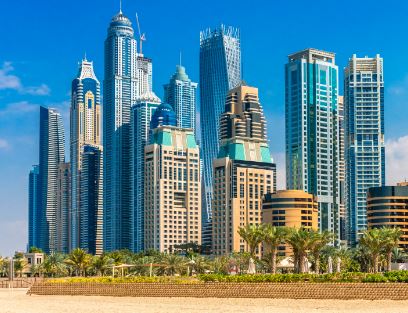Analysing sustainable skyscrapers in the UAE
By Shivram Mukherjee
In the past decade, sustainable design and practice was not identified by the Dubai Government as a means for innovative and profitable outcomes. This was largely due to the fact that clients, consultants and contractors were experiencing a period of substantial growth and stability in the construction industry. The mentality was simply to construct high rise buildings rapidly to meet the excessive demands of wealthy expatriates who were seeking instant profits and a life of luxury. Hence, sustainable practice was at best an afterthought, which was seen as an unnecessary expense for the client to invest in. However, the recent global crisis has put enormous strain on the city of Dubai, ultimately forced to seek alternative approaches to stay insulated during these tough times.
A collaborative approach seeking innovation through sustainability has recently been understood and acknowledged to produce positive outcomes, not only for the client and project team, but also for the occupants of the building. This understanding has been presented within the Dubai Strategic Plan 2015 and also in the BREEAM Gulf environmental rating system for construction professionals to adhere to.
In order to achieve this aim, five guiding principles have been identified within the Dubai Strategic Plan 2015. The guiding principle which addresses sustainable development is infrastructure, land and environment. The aim of this guiding principle is ‘to ensure proper focus on sustainable development within the context of Dubai’s considerable economic growth.’
Implementing ‘green’ objectives in future high rise buildings within Dubai
To successfully implement green objectives in high rise buildings ‘a strong understanding of existing conditions: environmental data, relationship to existing and future developments, and the policies in place that support site development’ must be achieved. It has been further detailed that this process stating ‘designers must understand and consider building orientation, opportunities for daylighting, generation of wind power, solar absorption and a site’s geothermal properties.
Recent developments
While the Al Bahar towers in Abu Dhabi have received acclaim and accolades as pillars of sustainable design, the project’s lead designer says that they are merely one step towards truly sustainable construction. The 25-storey skyscrapers, which serve as the Abu Dhabi Investment Council’s (ADIC) headquarters, have an external facade composed of 2,000 umbrella-like elements. These follow the sun, closing to block out heat while allowing in light. An array of solar panels on the roof is also utilised to heat water.
Upcoming trends in high rise
High rise towers of the future must not merely be measured by total height, instead its efficiency and impact on the environment will indicate how successful the development has been. Research carried out to date, indicates how future high rise design trends will encompass the mixed-use prototype. This works in unison with Dubai’s urban planning scheme involving creating ‘cities within a city’.
Projects such as the Burj Dubai, the Nakheel Tower and the Dynamic Tower all attempt to exemplify sustainable development and achieve varying levels of success. Hence, analytical criticisms of each of these developments can be made to further understand the future high rise design trend Dubai should be inspiring to.
By establishing these principles, members within the industry can contribute their knowledge and energy towards creating a prototype for greening tall buildings. This future high rise design trend will encompass a sustainable mixed-use approach, which responds to the growing 40 sustainable high-rise design trends – Dubai’s strategy demands of the economy through the implementation of intelligent ESD initiatives, resulting in a ‘green’ high rise tower solution. Further research could examine sustainable high rise design trends outside of Dubai and determine whether Dubai can implement some of these sustainable practices, to further improve their sustainable high rise prototype. Through this Dubai can address the basic principles and concept of sustainability: balancing a growing economy, protection for the environment, and social responsibility, which can together lead to an improved quality of life for future generations.
Shivram Mukherjee, is a senior consultant with First Climate (India) Private Limited and has been associated with Climate Change Sustainability Services since 2011. He holds a B.Tech Degree in Mechanical Engineering and a Master’s Degree in Energy Management. He has worked with Dubai Municipality (as a consultant) for a Greenhouse Gas Abatement Project registered under the Clean Development Mechanism for United Nations Framework Convention on Climate Change.





